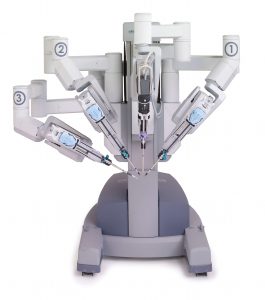Robotic Surgery
Robotic surgery is a type of minimally invasive surgery. “Minimally invasive” means that instead of operating on patients through large incisions, we use miniaturized surgical instruments that fit through a series of quarter-inch incisions.
When performing surgery with the da Vinci Si these miniaturized instruments are mounted on three separate robotic arms, allowing the surgeon maximum range of motion and precision. The da Vinci’s fourth arm contains a magnified high-definition 3-D camera that guides the surgeon during the procedure.
The surgeon controls these instruments and the camera from a console located in the operating room. With fingers placed into the master controls, the surgeon is able to operate all four arms of the da Vinci simultaneously while looking through a stereoscopic high-definition monitor that literally places the surgeon inside the patient, giving a better, more detailed 3-D view of the operating site than the human eye can provide. Every movement the surgeon makes with the master controls is replicated precisely by the robot.
When necessary, the surgeon can even change the scale of the robot’s movements: If the surgeon selects a three-to-one scale, the tip of the robot’s arm will move just one inch for every three inches the surgeon’s hand moves. And because of the console’s design, the surgeon’s eyes and hands are always perfectly aligned with the view of the surgical site, minimizing surgeon fatigue.
 The ultimate effect is to give the surgeon unprecedented control in a minimally invasive environment. Since these procedures can now be performed through very small incisions, our patients experience a number of benefits compared to open surgery, including:
The ultimate effect is to give the surgeon unprecedented control in a minimally invasive environment. Since these procedures can now be performed through very small incisions, our patients experience a number of benefits compared to open surgery, including:
- Less trauma on the body
- Minimal scarring
- Faster recovery time
How the da Vinci Si Works
The da Vinci Si has two separate but connected sections:
The tower, which is positioned directly over the patient during surgery, contains the robot’s four arms—three that can hold a multitude of different surgical instruments, and a fourth that holds the system’s 3-D cameras. These arms are controlled by a computer that exactly replicates the movements of the operating surgeon.
The console is where the surgeon sits and operates the robot’s controls while looking into a stereoscopic monitor that provides a magnified, high definition 3-D view of the surgical site. The surgeon manipulates the robot’s four arms by maneuvering two master controls that provide fingertip precision of movement.
The surgeon also operates a footswitch that provides additional options, such as the ability to switch between two different energy sources. Touchpads allow the surgeon to easily adjust video, audio and system settings, while the ergonomic console and the alignment of the controls and monitor are designed to keep the surgeon in a relaxed, focused position at all times.
